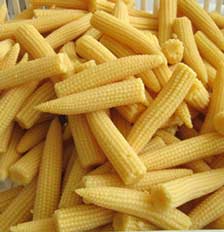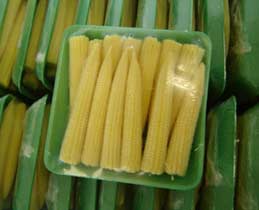Baby corn is a young finger like unfertilized cob of maize with 2 to 3 cm emerged silk preferably harvested with in 1-3 days of silk emergence depending upon the growing season. It can be eaten raw and included in diet in a number of ways such as salad, chutney, vegetables, pickles, kheer, Chinese preparations etc.
The desirable size of baby corn is 6-11 cm in length, and 1.0 to 1.5 cm in diameter with regular row arrangement which depends on the variety, population density and the cropping season (Figure A and B). The most preferred colour by the consumers is creamish to very light yellow.
It has great potential both for internal consumption as well as round the year export as 3-4 crops of baby corn can be taken in one year.
Thailand is the major baby corn producing and exporting country in the world, while India has emerged as one of the potential baby corn producing countries because of its low cost of production. Sub-tropical regions of Jammu, Samba and Kathua hold much promise in the cultivation of baby corn.
Being a short duration crop, the intensification of cropping both in temporal and spatial dimensions, high yields and profits can be realized in baby corn production. One of the pre-requisites for its commercial production is that the land should be irrigated and the soil should vary from loam to sandy clay loam with adequate drainage facility.
Moreover, the results of frontline demonstrations (FLD’s) laid down by Krishi Vigyan Kendra-Kathua have given encouraging results thereby providing the resource poor farmers of the region a viable and profitable crop to encourage diversification to new crops vis-à-vis traditional crops.
Nutritive Value of Baby corn
The nutritional quality of baby corn is at par or even superior to some of the seasonal vegetables. It is rich in proteins, vitamins and iron and is also one of the richest sources of phosphorus (Table 1). Also, being rich in fibrous protein and easy to digest it is extensively used in baby foods.
Baby corn is considered to be a safe vegetable as it is almost free from residual effects of pesticides because the young corn cobs are wrapped up with husk and well protected from insect pest damage.
[indeed-social-locker sm_list=’fb,tw,go1′ sm_template=’ism_template_1′ sm_list_align=’horizontal’ sm_display_counts=’false’ sm_display_full_name=’true’ locker_template=2 sm_d_text='<h2>This premium content is locked</h2><p>Share This Page To Unlock The Content!</p>’ ism_overlock=’default’ ]
Advantages of Baby corn
Some of the advantages of growing baby corn are:
- Diversification: It can promote and grown round the year.
- Employment generation: It provides employment in the form of cultivation, marketing, processing and export.
- Earning money in short span of time: Generally, farmers have to wait for a longer time for the income from their crops. Being a short duration crop, farmers can earn money in the shortest possible time.
- Potential for export: Baby corn has a great demand in the international market. The foreign exchange can be earned by exporting baby corn and its products.
- Quality fodder for live stock: Green fodder obtained after the harvesting of baby corn can be used as a feed to the livestock through out the year.
- Value addition: Value addition of baby corn is possible through preparation of several recipes viz. soup, pakoras, salad etc.
- Processing: Baby corn can be processed to improve its shelf-life and round the year availability through processes such as canning, dehydration and freezing.
Selection of suitable varieties
Short duration, prolific, single cross hybrids with medium height should be selected. Baby corn variety HM-4 is suitable hybrid for baby corn which has performed well in sub-tropical areas of North western India. Also, hybrid variety Prakash and composite variety Kesari are appropriate varieties for taking baby corn crop.
Baby Corn Recipes
There are a number of baby corn recipes developed by various institutes on the value addition of baby corn. Some of the examples of recipes available are baby corn tomato soup, baby corn vegetable soup, baby corn chutney, baby corn cutlet, baby corn chat, baby corn dry vegetable, baby corn kofta curry, baby corn mixed vegetables, baby corn masala, baby corn sweet and sour, baby corn manchurian, baby corn chilli, baby corn raita, baby corn pickle (sour), baby corn pickle (sweet n sour), baby corn candy, baby corn jam, baby corn murabba, baby corn burfi, baby corn halwa, baby corn kheer.
Constraints in its adoption
Despite better economic returns and increasing market demand in the international market, the cultivation of baby corn has not become popular in India due to following reasons:
- Less availability of quality seeds
- Unawareness among the common masses about its use and taste
- Lack of processing facilities.
- Lack of marketing facilities in rural areas.
Table 1. Nutritional composition of baby corn on dry matter basis (approx.)
| Particulars | Composition of baby corn |
| Moisture (g/100g) | 7.37 |
| Crude protein (g/100g) | 10.04 |
| Crude fat (g/100g) | 4.43 |
| Crude fibre (g/100g) | 2.40 |
| Ash (g/100g) | 1.34 |
| Total carbohydrates | 81.97 |
| Energy (Kcal/100g) | 375.67 |
| Total soluble sugars (g/100g) | 0.14 |
| Calcium (mg/100g) | 17.76 |
| Phosphorus (mg/100g) | 197.89 |
| Iron (mg/100g) | 2.73 |

A) Freshly harvested baby corn

B) Packaged baby corn for marketing baby corn
Contributed by:
Dr. Rajeev Bharat
Krishi Vigyan Kendra, Kathua
Sher-e-Kashmir University of Agricultural Sciences & Technology of Jammu
[/indeed-social-locker]








